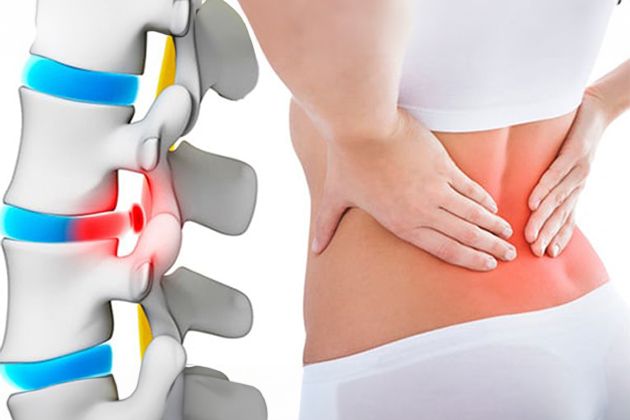
Cervical Herniated Disc
Structure and Functions of the Spine
Our spine consists of a total of 33 vertebrae and is divided into five sections. These sections are:
- 7 cervical (neck) vertebrae
- 12 thoracic (back) vertebrae
- 5 lumbar (waist) vertebrae
- 5 sacral (forming the sacrum) vertebrae
- 4 coccyx (tailbone) vertebrae.
The sacral and coccyx vertebrae are fused and do not move. The spine has three main functions:
- Enabling movement of the trunk
- Supporting the body in respiratory functions
- Protecting the spinal cord and nerve structures.
Our spine contains over 13 million neurons, 220 ligaments, more than 120 muscles, and over 100 joints. The average weight of the spinal cord, which is protected by the spine, is 35 grams. Our spine can perform movements such as bending forward and backward, rotating to the right and left, and rotating on its own axis.
Risk Factors for Cervical Herniated Disc
- Age: Discs tend to degenerate more with age, especially in individuals over 40.
- Genetic Factors: Family history can increase the risk of cervical herniated disc.
- Gender: The risk is slightly higher in men compared to women.
- Smoking: It can negatively affect circulation, making it difficult for the discs to be nourished.
- Occupational Factors: Heavy lifting jobs can increase the risk of cervical herniated disc.
- Inactivity: Lack of physical activity can weaken the neck muscles.
- Obesity: Excess body weight puts additional pressure on the spine and discs.
- Poor Posture: Incorrect posture habits can lead to improper positioning of the neck vertebrae and discs.
- Trauma and Accidents: Blows or trauma to the neck region can cause disc injury.
- Rheumatoid Arthritis: Rheumatologic diseases can cause inflammation of the neck vertebrae and discs.
Symptoms
Symptoms of a cervical herniated disc can vary in intensity and form from person to person:
- Neck Pain: The most common complaint is pain in the neck region.
- Shoulder Pain: It can cause pain in the shoulders, extending to the arm and shoulder area.
- Numbness in the Arms and Hands: Pressure on the nerve roots can cause numbness or a tingling sensation.
- Muscle Weakness: It can cause muscle weakness if it presses on the nerve roots.
- Headaches: It can spread from the back of the neck to the top of the head.
- Urination and Defecation Problems (Rare): In advanced stages, it can press on the spinal cord.
Diagnosis
Diagnosis of a cervical herniated disc is made based on the patient’s clinical symptoms and imaging methods. The most commonly used method is magnetic resonance imaging (MRI), which provides detailed information about the condition, location of the disc, and its effects on the nerve roots. Additionally, computed tomography (CT), X-ray, and electromyography (EMG) tests are also helpful in diagnosis.
Treatment
Non-Surgical Treatment:
- Use of neck braces
- Bed rest
- Pain relievers and muscle relaxants
- Exercise and physical therapy
Surgical Treatment:
- Microdiscectomy: A minimally invasive method performed using a surgical microscope. The patient receives general anesthesia, and special retractors are used to reach the spine. The damaged disc is removed, and sometimes fusion is also performed.
- Laminectomy: A procedure in which bone plates are removed to provide more space for the spinal cord.
Post-Surgery Considerations
- Following the doctor’s recommendations
- Paying attention to wound care
- Starting with low-impact activities
- Avoiding heavy lifting
- Using a neck pillow or neck brace
- Regular check-ups
The complete recovery process after cervical herniated disc surgery spans 3 months and beyond. During this period, maintaining a healthy lifestyle, adhering to the doctor’s recommendations, and not neglecting regular check-ups is important.
Featured Videos
Frequently Asked Questions
A cervical hernia occurs due to the degeneration or injury of the discs in the cervical spine. These discs serve as cartilage structures that protect the spinal cord and nerve roots. A cervical hernia can cause various neurological symptoms by exerting pressure on the nerve roots due to the gel inside the discs leaking or protruding out. The primary pathology of a cervical hernia arises from the compression or tearing of the cervical spine discs. This condition prevents the discs from performing their normal functions and causes pressure on the surrounding nerve tissues. The leakage of the gel inside the discs can lead to inflammation and nerve damage. Therefore, the mechanism of cervical hernia disease includes both mechanical and inflammatory components.
Symptoms of a cervical hernia include neck pain, numbness and tingling in the shoulder, arm, or hand, weakness in the arm or hand, headaches, and restricted neck movements. In some cases, pain and numbness may extend to the legs due to pressure on the nerve root.
The diagnosis of a cervical hernia is based on the patient’s complaints and physical examination findings. Imaging methods such as MRI (Magnetic Resonance Imaging), CT (Computed Tomography), and X-rays are used to confirm the diagnosis and determine the location and severity of the hernia. An EMG (Electromyography) test can also be used to assess the extent of nerve damage.
The recovery process after cervical hernia surgery varies depending on the type of surgical intervention performed and the overall health condition of the patient. Post-surgery physical therapy and rehabilitation are important to accelerate the recovery process and maintain spinal health. Post-operative care includes adhering to the exercise program recommended by the doctor, using prescribed medications for pain management, and avoiding heavy lifting or strenuous activities. Regular follow-ups and compliance with the doctor’s instructions are also crucial during the recovery period.

